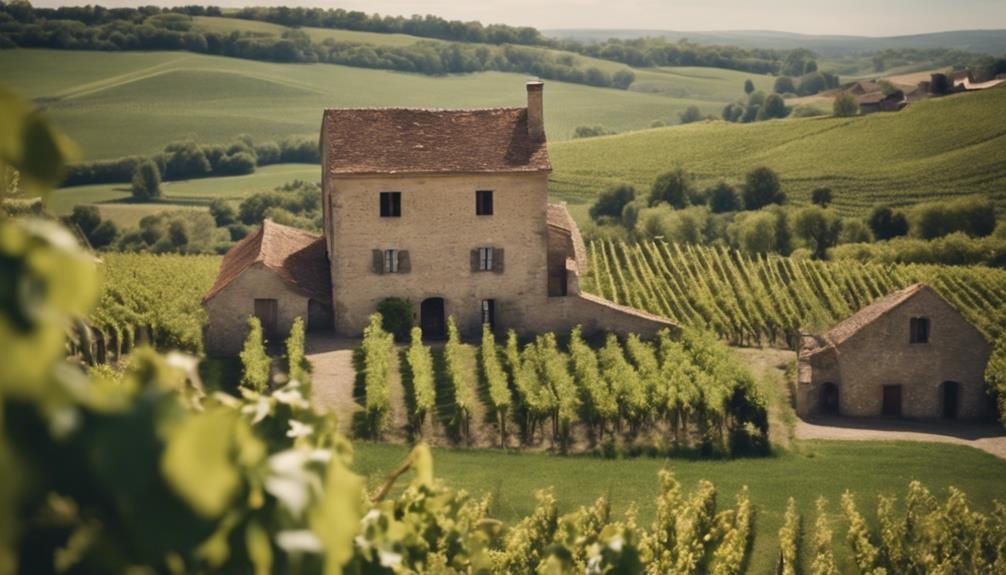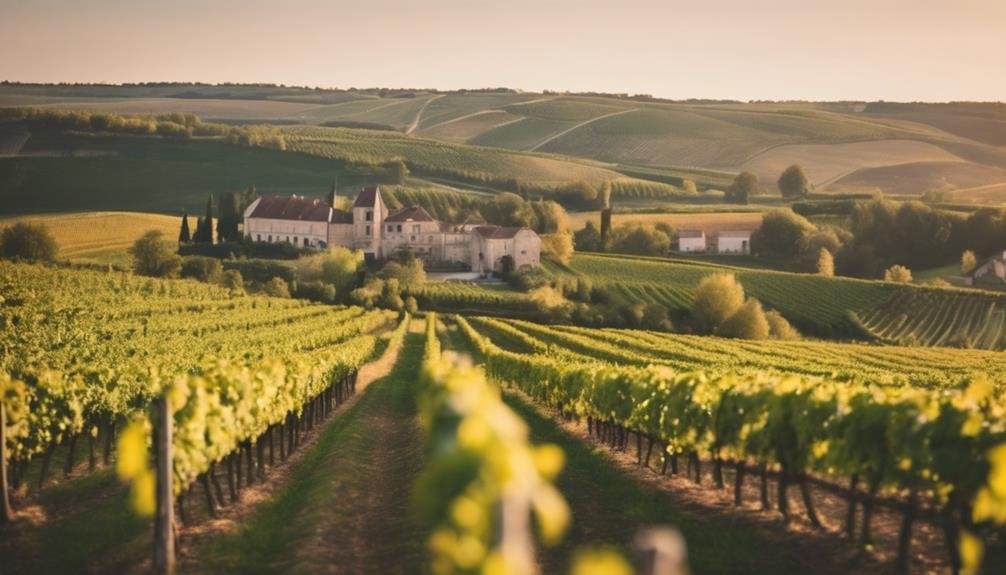Nestled in the Aube region, separate from Marne, Côte Des Bar shines in Champagne. Its Kimmeridgian soil, akin to Chablis, blesses Pinot Noir with a mineral charm. Pinot Noir's revival showcases its flair while Chardonnay's rise adds depth. The region's history, marked by protests in 1908, fuels its unique spirit. Subtle climate variations yield diverse flavors, upheld by sustainable practices. Figures like Vincent Couche champion quality and sustainability, elevating the region's fame. Each sub-region weaves a rich tapestry, enriching Côte des Bar's winemaking legacy. Discover more about this rising Champagne gem.
Côte Des Bars Unique Terroir
Nestled in the Aube region separate from the Marne département, Côte des Bar boasts a unique terroir characterized by Kimmeridgian soil akin to Chablis, creating an ideal environment for the cultivation of Pinot Noir grapes.
The Kimmeridgian influence in the soil imparts distinctive mineral qualities to the grapes, enhancing the complexity of the wines produced. Pinot Noir, with its delicate balance of fruitiness and acidity, thrives in this environment, showcasing its prominence in the region's vineyards.
This terroir not only shapes the flavors of the wines but also contributes to the overall character and quality that Côte des Bar wines are known for. Wine enthusiasts appreciate the nuanced expressions of Pinot Noir that this unique terroir yields, making Côte des Bar a rising star in the world of Champagne production.
Evolution of Grape Varieties
In the dynamic landscape of Côte des Bar's wine production, the evolution of grape varieties reflects a strategic adaptation to changing consumer preferences and climatic conditions.
- Pinot Noir resurgence: Traditionally dominant in the region, the renewed focus on Pinot Noir showcases its versatility and quality in Côte des Bar's terroir.
- Chardonnay expansion: With increasing plantings of Chardonnay, producers are exploring the full potential of this grape, adding complexity and diversity to the region's wines.
- Embracing diversity: The introduction of new grape varieties alongside the classic trio demonstrates a commitment to innovation and experimentation in winemaking.
- Sustainability in viticulture: Producers are incorporating sustainable practices in grape cultivation, ensuring the longevity of vineyards and the preservation of the unique terroir of Côte des Bar.
Revolutionary History of Côte Des Bar

The Revolutionary History of Côte Des Bar unfolds as a narrative of resilience and innovation within the domain of Champagne production.
In 1908, Côte Des Bar experienced riots, reflecting the region's dissatisfaction with its treatment as a second Champagne zone until 1927. This classification relegated the area to a secondary status for decades, prompting local producers to challenge traditions and push for recognition.
Despite facing adversity, Côte Des Bar's winemakers maintained their commitment to quality and excellence, cultivating a reputation for determination and a willingness to overcome obstacles.
This tumultuous past has shaped the region's identity, giving it a unique character and a chip on its shoulder that continues to drive its pursuit of distinction within the Champagne world.
Exploring the Sub-Regions
Notable for their distinct characteristics and contributions to the diverse tapestry of Champagne production, the sub-regions within Côte des Bar each possess a unique essence that adds depth to the region's winemaking heritage.
- Vineyard sustainability: The sub-regions in Côte des Bar prioritize sustainable practices, ensuring the longevity of their vineyards and the environment.
- Climate impact: Each sub-region's specific climate influences the grapes grown, resulting in nuanced flavors and styles of Champagne.
- Terroir diversity: From Barséquanais to Rosé des Riceys, the sub-regions showcase a range of terroirs, contributing to the complexity of Côte des Bar's wines.
- Cultural significance: Historical events and traditions within each sub-region enrich the cultural tapestry of Champagne production in Côte des Bar.
Influential Figures in Côte Des Bar

Within the dynamic landscape of Côte des Bar's winemaking domain, notable figures emerge as key influencers shaping the region's evolving narrative. Innovative winemakers like Vincent Couche, known for his biodynamic practices, have revolutionized traditional winemaking techniques, emphasizing sustainability and quality. Their dedication to producing exceptional Champagnes has garnered international acclaim, putting Côte des Bar on the map as a region of innovation and excellence.
Furthermore, community engagement plays an essential role in the development of Côte des Bar, with winemakers actively participating in local events, supporting small businesses, and promoting the region's cultural heritage. Through their collaborative efforts, these influential figures not only enhance the reputation of Côte des Bar but also contribute to the growth and prosperity of the local community.
Frequently Asked Questions
How Has the Climate Change Impacted Grape Growing in Côte Des Bar?
The impact of climate change on grape growing in Côte des Bar has influenced grape resilience. Shifts in temperature and weather patterns have prompted growers to adapt vineyard practices, emphasizing sustainability and innovation to guarantee grape quality and yield.
What Are the Key Differences Between Côte Des Bar and Other Champagne Regions?
In comparing Côte des Bar to other Champagne regions, notable differences emerge in soil composition favoring Kimmeridgian soil akin to Chablis, vineyard management by non-full-time growers, unique microclimate variations enhancing Pinot Noir, and increasing Chardonnay plantings.
How Do Local Traditions Influence Winemaking Practices in Côte Des Bar?
Local traditions in Côte des Bar greatly influence winemaking practices, honoring cultural heritage. These customs guide vineyard management, harvest timing, and cellar techniques, shaping a unique Champagne style that reflects the region's rich history and sense of identity.
What Makes the Kimmeridgian Soil in Côte Des Bar Unique for Grape Growing?
The distinct Kimmeridgian soil composition in Côte des Bar enhances grape quality by providing excellent soil drainage and fostering unique microclimate effects. This geological feature contributes to the region's reputation for producing exceptional Champagne grapes.
Are There Any Unique Winemaking Techniques Specific to Côte Des Bar?
Barrel fermentation and extended maceration are notable winemaking techniques in Côte des Bar. These methods contribute to the region's unique expressions, enhancing complexity and structure in the Champagnes produced, setting them apart in the industry.
Conclusion
Côte des Bar, Champagne's rising star, shines with its unique terroir, evolving grape varieties, revolutionary history, and diverse sub-regions. Influential figures have shaped this region into a force to be reckoned with in the world of fine wines.
With a rich historical heritage dating back centuries, Côte des Bar continues to attract attention for its exceptional wines and promising future. Embrace the allure of this lesser-known Champagne gem and savor the fruits of its labor.
